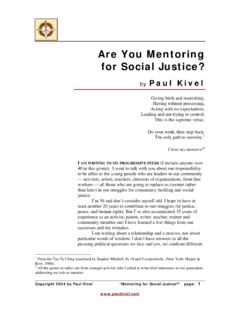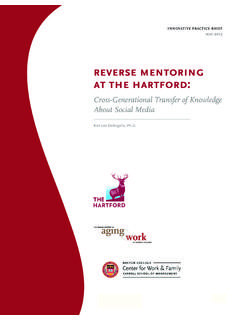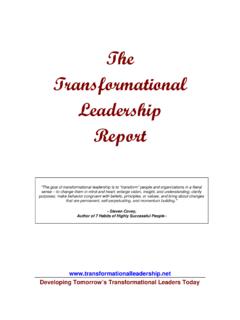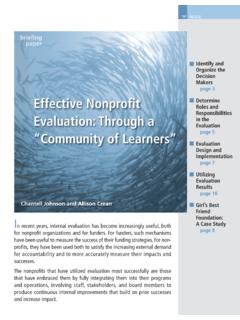Transcription of The Social Norms Approach: Theory, Research, and …
1 The Social Norms approach : Theory, Research, and Annotated Bibliography August 2004 Alan D. Berkowitz, Independent Consultant Trumansburg, NY, 14886-0701 The original version of this paper was written in August 2000. Since then, three revisions have been posted: in August 2001, in January 2003 and this revision of August 2004. To insure that you have the most recent version of this paper please contact the author before citing. Social Norms Theory and Research (Berkowitz) - 2 Preface The State of Social Norms Prevention approaches that provide normative feedback are growing by leaps and bounds in popularity and evidence is mounting that these programs can be effective when correctly implemented.
2 As a result there is a need for a comprehensive review of the Social Norms literature to provide practitioners with an overview of important research, to summarize the evaluation literature regarding its effectiveness, and to address questions and concerns. It is my hope that this review will serve this purpose. I am grateful to the Higher Education Center for Alcohol and Other Drug Prevention for allowing me to revise it annually since 2000 to keep pace with the important changes and developments in this field. The growing interest in Social Norms and evidence for its efficacy is indicated by a number of trends. Interventions that correct misperceived Social Norms are currently being funded by over five Federal agencies and by dozens of State agencies, non-profit organizations, consortia and, less often, by the alcohol beverage industry.
3 Well-implemented Social Norms programs have received numerous awards, including two model program awards by the Center for Substance Abuse Prevention and many from the Department of Education. Research about Social Norms and its effectiveness frequently appears in scholarly journals and other professional publications. The evidence for the Social Norms approach was summarized in 2002, when, as part of a comprehensive effort to examine college drinking, the National Institute on Alcoholism and Alcohol Abuse (NIAAA) appointed an expert panel of approximately twenty national prevention specialists to make recommendations for the field.
4 Communicating accurate Social Norms was among the strategies suggested by this panel, which commented in its final report that: Initial results from programs adopting an intensive Social Norms approach are promising. Several institutions that persistently communicated accurate Norms have experienced reductions of up to twenty percent in high-risk drinking over a relatively short period of Together these findings provide strong support for the potential impact of the Social Norms approach . Although any case report in this literature could be challenged methodologically, the results of each study are remarkably consistent. (NIAAA, p.)
5 13, 2002) Since the NIAAA report numerous new studies have provided additional evidence for Social Norms efficacy. In addition to addressing alcohol use with Social Norms marketing campaigns other programs have demonstrated the effectiveness of Social Norms interventions in reducing or preventing cigarette smoking, reducing DWI, changing attitudes associated with rape proclivity in men, and reducing sexual assault. Positive results have been obtained with college and university students, with high school and middle-school populations, and in defined populations such as sorority and fraternity members, athletes, and first-year college students, and with individuals, groups, and communities.
6 More recently, a number of Social Norms interventions have been evaluated and found to be successful without parallel changes in comparison groups. In Social Norms Theory and Research (Berkowitz) - 3addition, some evaluation research suggests that when programs incorporate Social Norms as part of a comprehensive intervention using multiple strategies, the Social Norms component is often one of the important ingredients associated with program effectiveness. With the growth of the Social Norms approach , concerns have been expressed about its efficacy in general and with specific populations in particular.
7 Some of these concerns arise from findings that may be attributable to implementation problems such as inadequate exposure to messages, and strategies that are not faithful to the model. Another problem that may mask program success is lack of adequate evaluation. Other concerns are spurred by debates about important issues in the field for example, whether Social Norms should be part of a larger package of interventions or whether it can be implemented by itself, and whether campaigns should be directed at more homogeneous sub-groups rather than larger communities. Finally, other criticisms may be based on misinformation about the approach or lack of familiarity with the research evidence.
8 Responses to these concerns are incorporated into the text of this review. The primary purpose of this paper is to summarize what we know about Social Norms by reviewing the published research literature on the Social Norms model rather than to provide advice on how to conduct an intervention. Advice on implementation strategies and case studies of successful projects can be found by consulting following resources: The website of the National Social Norms Resource Center ( ) The Social Norms section of the Higher Education Center for Alcohol and Other Drug Prevention s Website ( ), The Report on Social Norms , a monthly publication from PaperClip Communications ( ) that provides research reviews, examples of model programs, and commentaries on current issues, The Social Norms approach to Preventing School and College Age Substance Abuse.
9 A Handbook for Educators, Counselors and Clinicians, the first book on the Social Norms approach , containing numerous case studies of successful interventions, theoretical issues, and implementation strategies (published in 2003 by Jossey-Bass), The National Conference on the Social Norms Model, an annual conference that meets each summer to provide an intensive collegial opportunity for researchers, theorists, and practitioners to explore the state of the art of the Social Norms approach (for information go to ), and: The Social Norms Resource Book, a comprehensive overview of the Social Norms approach covering implementation strategies for individuals, groups, and communities and topical areas such as alcohol abuse and smoking prevention, sexual assault prevention, and other innovative applications, available from Social Norms Theory and Research (Berkowitz) - 4 PaperClip Communications (for information go to: , , or call 866 295-0505).
10 This August 2004 review differs from its predecessors in a number of ways. The text has been edited for improved readability. Results of over 60 new studies, articles and/or resources have been incorporated, and the annotated bibliography has been updated and expanded. New sections have been added covering types of Norms , misperceptions in specific subpopulations (athletics, Greeks, gender and ethnicity), and issues in the evaluation of Social Norms campaigns. Finally, the scope of the review has been expanded from a focus on college and university Social Norms interventions to include high school, middle-school, and community settings.






